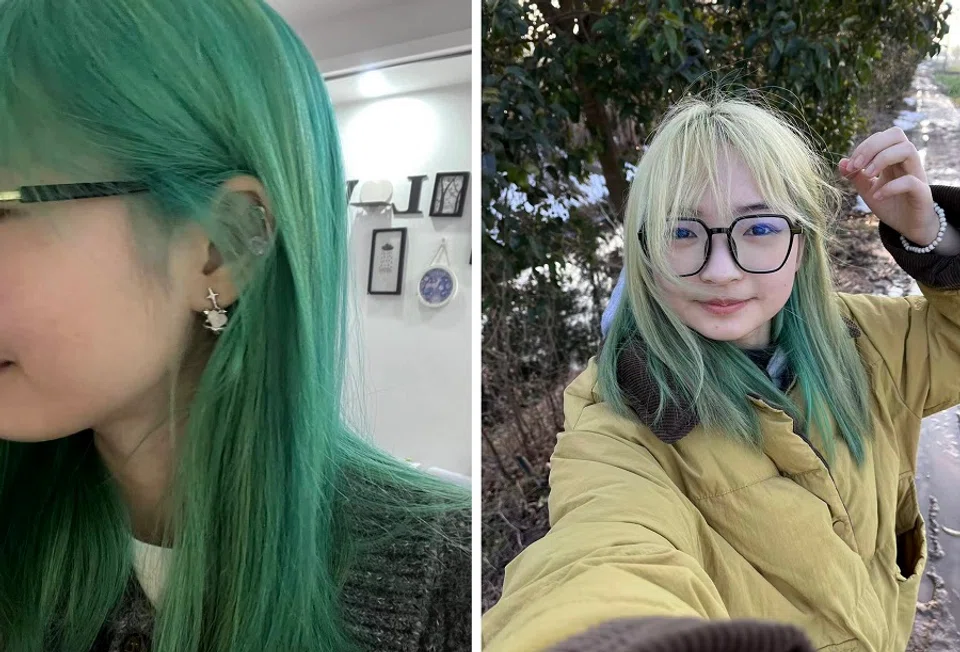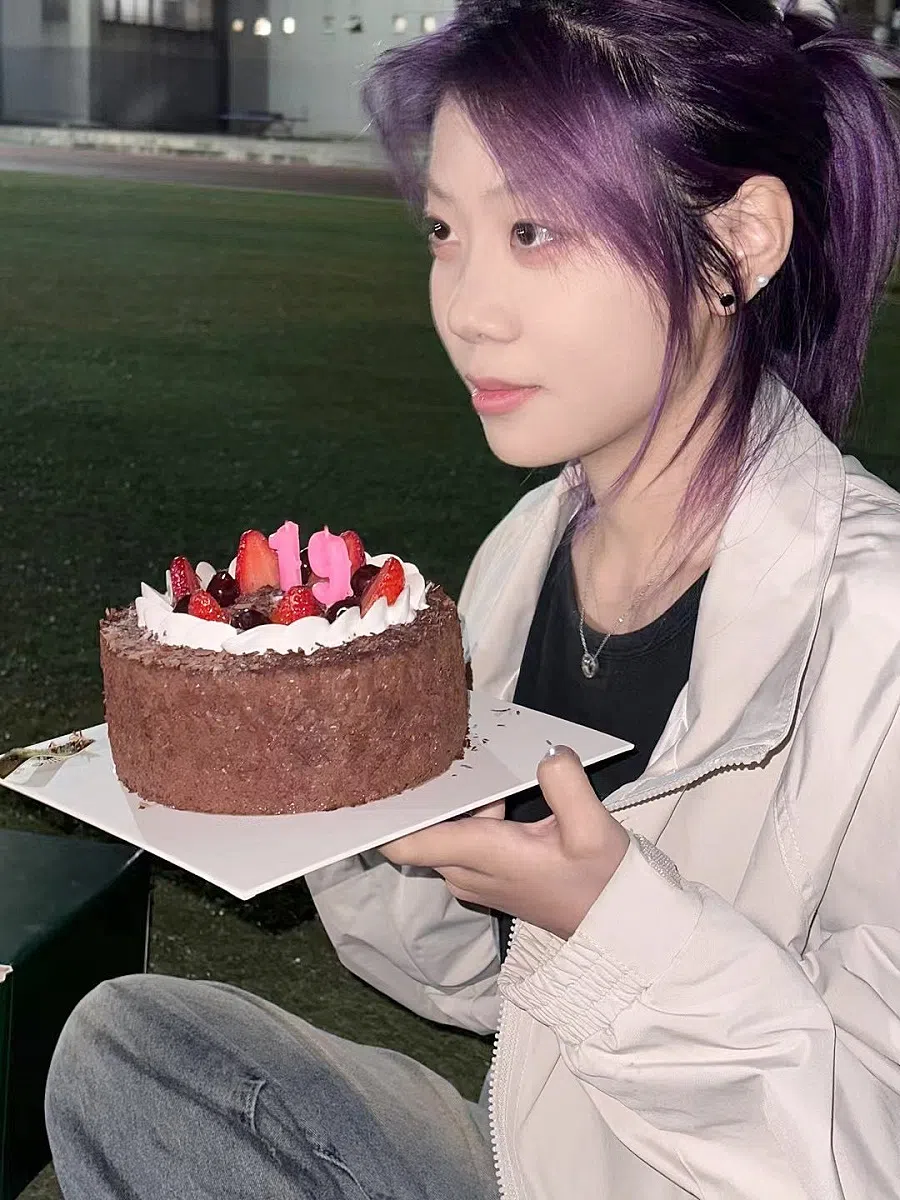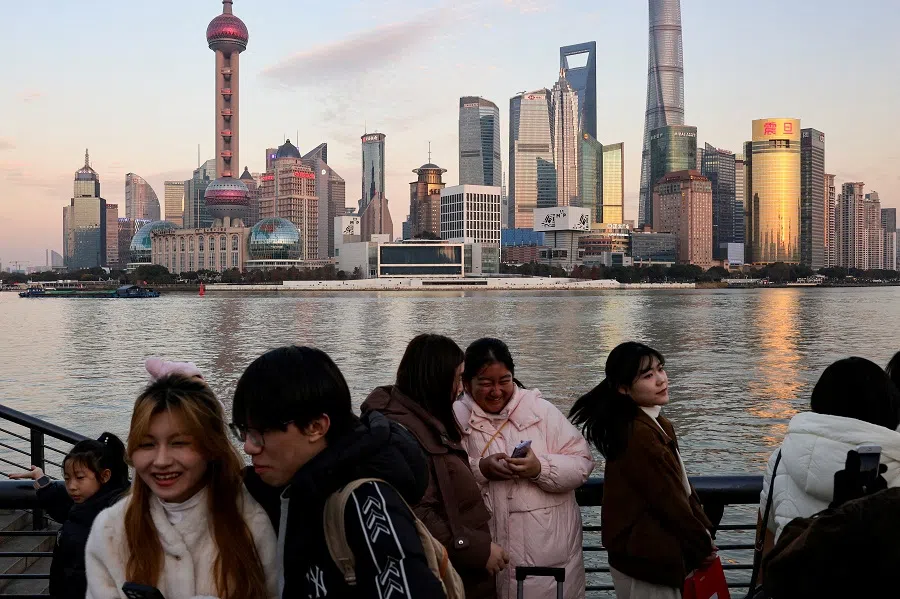Dyeing to express themselves: China’s Gen Z youths
Gone are the days where vibrantly dyed hair attracts judgemental stares. These days, many Chinese Gen Z youths are stepping out in eye-catching, unconventional hairstyles that celebrate their self-expression. Lianhe Zaobao Shanghai correspondent Li Kang tells us more.

After experimenting with blue, chestnut brown and dirty orange, Hou Yameng, a post-00s Chinese girl, dyed her hair for the fourth time — this time ending up with a head of striking green hair.
In an interview with Lianhe Zaobao, Hou described her hair colour as a shade between blue and green, like that of virtual singer Hatsune Miku. She chose this colour to add some flair to her “very plain” appearance.
In China, more and more Gen Z-ers like Hou are dyeing their hair. For this group of youths born between 1995 and 2009, dyeing their hair is no longer seen as a symbol of rebellion or irresponsibility; instead, it has become a form of self-expression.
All three Gen Z interviewees have dyed their hair at least four times. Among their friends and classmates, a third to half of their peers have already dyed their hair, while another third are considering it.
No colours are off-limits
Compared to the traditional red and brown hues, Gen Z’s choice of hair colours is more diverse and much bolder. From striking blues, greens, pinks and purples to trendy shades like granny grey, neptune red, and milk tea gold — no matter how vibrant the colour, youths are willing to try it out.
Among these colours, platinum blonde, which requires multiple bleaching sessions, is a must-try for newcomers looking to master the art of hair dyeing. On the Chinese social media platform RedNote, there are over 2 million posts related to “platinum blonde hair colour”, with views hitting 340 million.
For Lin, choosing a hair colour is no different from deciding where to eat or what to wear, adding that “if I want to do something, I just do it; if I want to try a colour, I’ll just try it”.

Lin Jiayu (pseudonym), a student at Wuhan University, bleached her hair platinum blonde just before her 19th birthday.
Lin recalled having to attend classes during the day, which meant she could only visit the salon at night. It took two consecutive nights of bleaching to eliminate her previous red hair and achieve a platinum blonde sheen that made her stand out in a crowd.
However, two months later, Lin dyed her hair once more, transforming her hard-earned platinum blonde hair purple. Like her previous dyeing experiences, the decision was made on a whim. Lin noted, “I was shopping when I suddenly thought, why not dye my hair. The next thing I know, I was already sitting in the salon”.
For Lin, choosing a hair colour is no different from deciding where to eat or what to wear, adding that “if I want to do something, I just do it; if I want to try a colour, I’ll just try it”.
Post-gaokao hair dyeing
It is not just girls who are dyeing their hair; 20-year-old Zhang Zerui (pseudonym) joined the trend after completing his gaokao. He first thought about dyeing his hair back in primary three.
At around ten years old, Zhang dreamed of dyeing his hair blue, something he considered “wickedly cool”. He eagerly asked his parents the next morning for permission, only to face the expected rejection.
Since a university in Xi’an faced online backlash in 2019 for discouraging students from dyeing their hair, few universities have implemented strict regulations on hair colour in recent years.

However, the idea of dyeing his hair had already been planted in his heart. After the gaokao, he realised it was something he had always wanted to do and saw it as his last chance to experiment before entering the workforce. Zhang explained, “I told my parents that my undergraduate years are the perfect time to dye my hair and that I want to change my hair colour every semester. If I don’t do it now, am I supposed to wait until I start working?”
Although Zhang’s parents always believed that “not having black hair is strange”, they eventually relented and even became his hair-dyeing “sponsors”. In addition to his regular allowance, they provided an extra “hair-dyeing fund”, which Zhang has already used four times.
On Chinese university campuses, attitudes towards dyed hair are quietly shifting among the school authorities, staff and students as well. Since a university in Xi’an faced online backlash in 2019 for discouraging students from dyeing their hair, few universities have implemented strict regulations on hair colour in recent years.
After Lin dyed her hair, the feedback she received from her classmates and instructors were mostly positive. “Even if there were a few less positive ones, no one forced me to dye it back,” she said.
Zhang, an English major, also thinks that the teachers in his department are very open-minded about dyed hair, not only not criticising the behaviour but even complimenting students on their hair colour.

However, some have also faced consequences for unconventional hair colours. Hou, a class committee member, was once told by a teacher that her light hair colour was unsuitable for participating in department activities.
Notwithstanding, Hou does not regret dyeing her hair. However, as she is about to graduate from university this year, she is ready to dye her hair back to a darker colour. “Going to a job interview with a flamboyant hair colour will definitely negatively impact their impression of me,” she admitted.
However, she added that this temporary compromise does not mean that she has given up on dyeing her hair. “When I am sufficiently capable, I’ll make the choices I truly want, regardless of hair colour,” she asserted.
... youths are also fulfilling their need for personal psychological development and emotional expression by dyeing their hair to express their individuality. — Wei Zhizhong, Chief Psychological Counsellor, Yiweiduxin Psychology Counselling Clinic, Guangzhou
Greater social acceptability
Wei Zhizhong, chief psychological counsellor at Guangzhou’s Yiweiduxin Psychology Counselling Clinic (一苇渡心心理咨询), told Lianhe Zaobao that traditionally, the Chinese saw hair as “roots within one’s bones”, a symbol of soul and life itself. But now, they are able to accept short hair, shaved heads and also vibrant hair colours. This highlights Chinese culture’s ability to break through tradition and embrace cross-cultural influences.
At the same time, Wei thinks that youths are also fulfilling their need for personal psychological development and emotional expression by dyeing their hair to express their individuality. The growing number of people dyeing their hair in China reflects increasing social acceptability, which is a positive trend.

Just two years ago, Zheng Linghua, a post-95 youth who proudly shared her acceptance letter from a prestigious university with her grandfather, became the target of cyberbullying and insults like “nightclub girl” and “improper” simply because she had pink hair. Unable to withstand the online abuse, she dyed her hair back to black but took her own life due to severe depression. Subsequently, numerous youths stood up for Zheng, dyeing their hair pink as an act of protest.
Wei said that when society is breaking through mindset barriers, conflicts and confrontations are inevitable, and the process of breaking through sometimes also results in sacrifices. “However, if the overall number of people breaking through these barriers is increasing, society is still moving towards becoming more open,” he said.
When asked if she had anything else to add before the end of our interview, Lin voluntarily brought up Zheng’s incident. She said that if that had happened today, the outcome could have been different. “If she was my friend, I would tell her not to be too bothered by what others think,” she said.
This article was first published in Lianhe Zaobao as “中国“Z世代”纷染发展示亮丽自我”.





